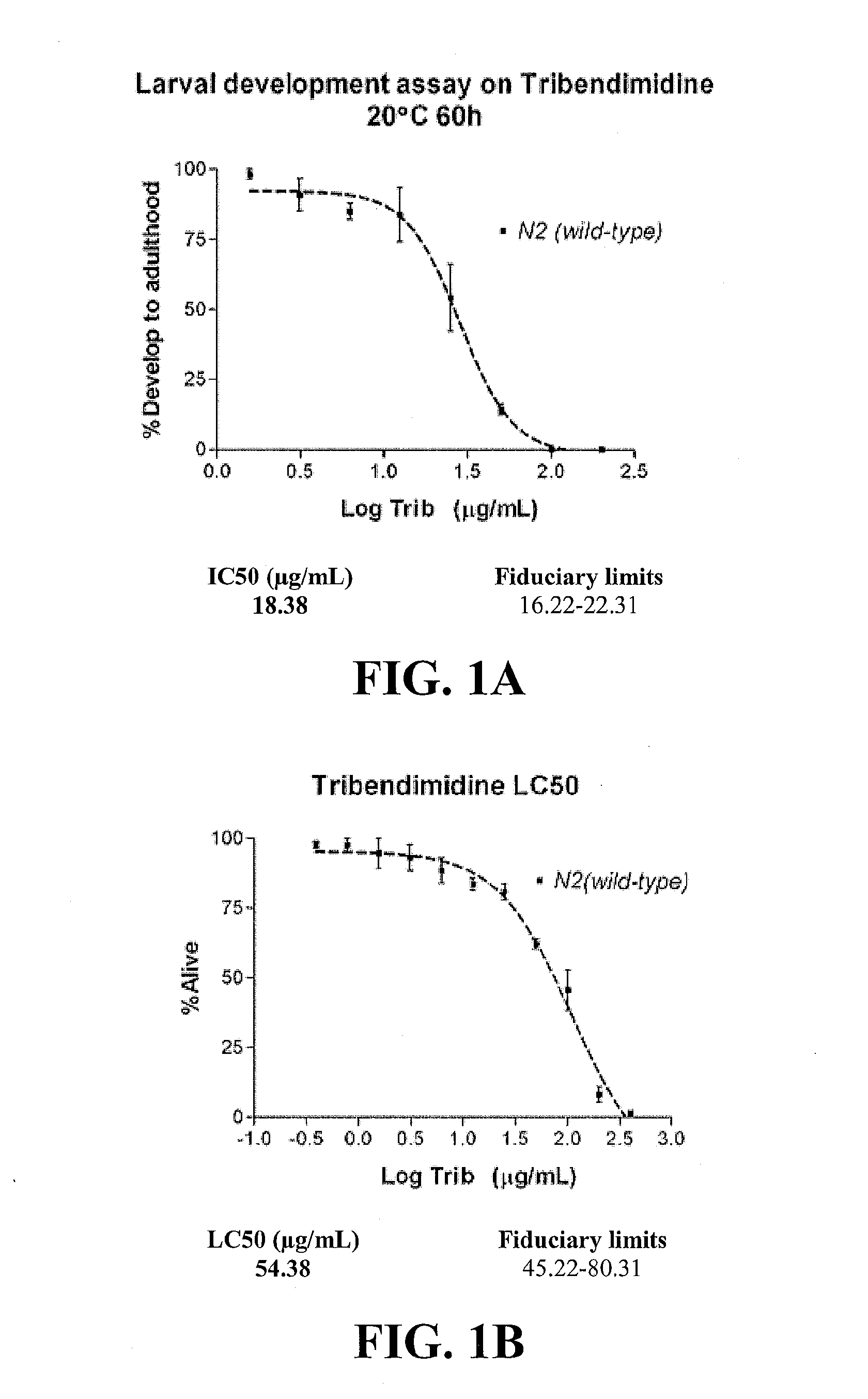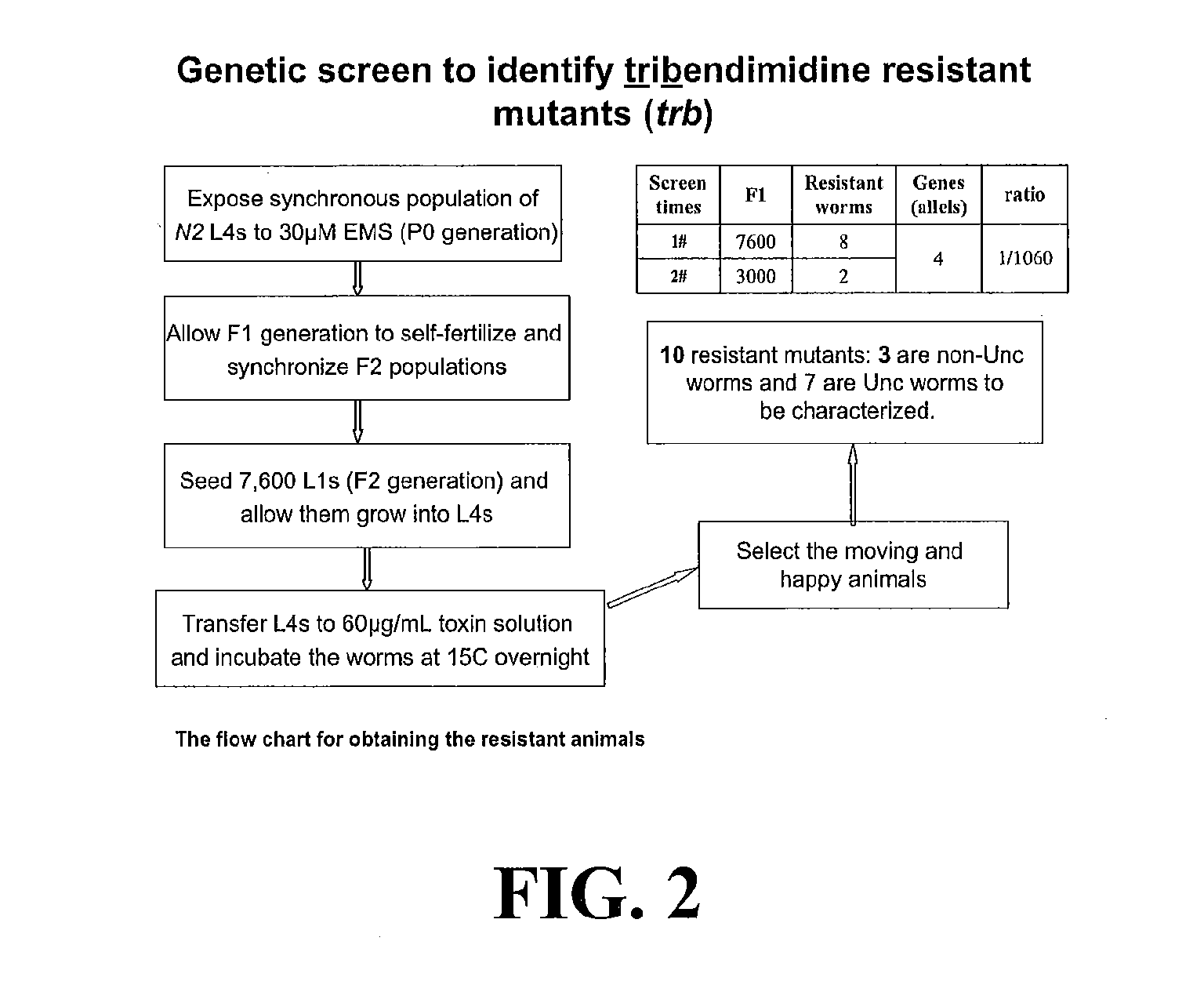[0011]In another embodiment, methods of treating a parasitic worm or helminth infection in a subject are described. The method includes the step of administering to the subject synergistically effective amounts of a crystal protein and a nicotinic acetylcholine receptor agonist. The crystal protein and the nicotinic acetylcholine receptor agonist may have a synergistic effect on the parasitic worm or helminth infection greater than the additive nematicidal effect of each of the crystal protein and the nicotinic acetylcholine receptor agonist administered separately or in combination as predicted by a simple additive effect of the two drugs. In such a case, the synergistically effective amount of the crystal protein is less than the amount needed to treat the parasitic worm or helminth infection if the crystal protein was administered without the nicotinic acetylcholine receptor agonist. Similarly, the synergistically effective amount of the nicotinic acetylcholine receptor agonist is less than the amount needed to treat the parasitic worm or helminth infection if the nicotinic acetylcholine receptor agonist was administered without the crystal protein. The synergistic amount of the crystal protein and of the nicotinic acetylcholine receptor agonist may have a synergism factor (CI value) of less than about 0.9, alternatively less than about 0.85, alternatively less than about 0.8, alternatively less than about 0.75, alternatively less than about 0.7, alternatively less than about 0.65, alternatively less than about 0.6, alternatively less than about 0.55, alternatively less than about 0.5, alternatively less than about 0.45, alternatively less than about 0.4, alternatively less than about 0.35, alternatively less than about 0.3, alternatively less than about 0.25, alternatively less than about 0.2, alternatively less than about 0.15, alternatively less than about 0.1. In addition, the use of two drugs that act synergistically and that define a hypersusceptible pairing would act to preserve the efficacy of both over time because the development of resistance to each one would be predicted to be significantly delayed.
[0012]In yet another embodiment, methods of treating a parasitic worm or helminth infection in a subject are described that include the step of administering to the subject synergistically effective amounts of Cry5B and a nicotinic acetylcholine receptor agonist from the levamisole family, which includes but is not limited to levamisole, pyrantel, and tribendimidine. These agonists are thought to mechanistically target nematodes in a manner similar to levamisole, The Cry5B and nicotinic acetylcholine receptor agonists from the levamisole family may have a synergistic effect on the parasitic worm or helminth infection greater than the additive nematicidal effect of each of the Cry5B and nicotinic acetylcholine receptor agonist from the levamisole family administered separately or in combination as predicted by a simple additive effect of the two drugs. In such a case, the synergistically effective amount of the Cry5B is less than the amount needed to treat the parasitic worm or helminth infection if the Cry5B was administered without the nicotinic acetylcholine receptor agonist from the levamisole family. Similarly, the synergistically effective amount of the nicotinic acetylcholine receptor agonist from the levamisole family is less than the amount needed to treat the parasitic worm or helminth infection if the nicotinic acetylcholine receptor agonist from the levamisole family was administered without the Cry5B. The synergistic amount of the Cry5B and of the nicotinic acetylcholine receptor agonist from the levamisole family may have a synergism factor (CI value) of less than about 0.9, alternatively less than about 0.85, alternatively less than about 0.8, alternatively less than about 0.75, alternatively less than about 0.7, alternatively less than about 0.65, alternatively less than about 0.6, alternatively less than about 0.55, alternatively less than about 0.5, alternatively less than about 0.45, alternatively less than about 0.4, alternatively less than about 0.35, alternatively less than about 0.3, alternatively less than about 0.25, alternatively less than about 0.2, alternatively less than about 0.15, alternatively less than about 0.1. In addition, the use of two drugs that act synergistically and that define a hypersusceptible pairing would act to preserve the efficacy of both over time because the development of resistance to each one would be predicted to be significantly delayed.
[0013]In yet another embodiment, methods of treating a parasitic worm or helminth infection in a subject are described that include the step of administering to the subjec
 Login to View More
Login to View More 


